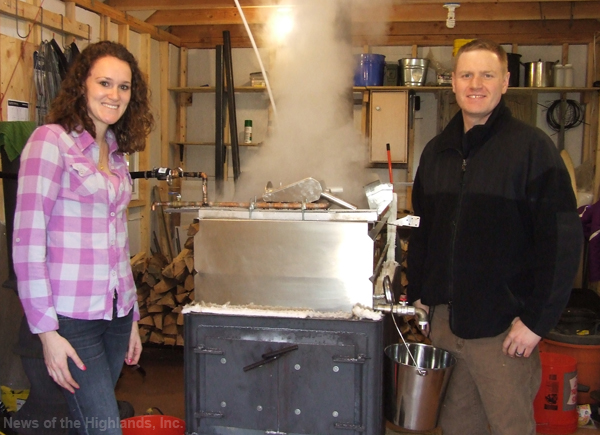
When one thinks of hobbies, collecting coins, stamps, comic books, or baseball cards come to mind. Some people in Cornwall raise chickens, but Matt Stack decided to do something different – he taps trees for sap and creates maple syrup, candy, and cream.
“It’s almost like farming,” said the 2006 Cornwall High School graduate. “You’re taking a product off your land and you’re making [something] edible. Not a lot of people make syrup. You need the right equipment, time, and willingness.”
The hobby began four years ago with about 20 taps, some five gallon jugs, a flat pan and a stove. Stack’s operation has now expanded to 150 taps, tanks instead of jugs, and an evaporator in lieu of the pan and stove. About nine taps are located on his property while the remainder are on his parents’ property on Berry Hill.
The maple syrup season unofficially begins Presidents’ Day weekend and lasts six weeks through the end of March.
“You start looking at the long-term forecast of freezing temperatures at night and above freezing, around 40/45 [degrees], during the day,” Stack said. “That causes the sap in the tree to freeze and become pressurized. When it thaws it pushes the sap out of the tap.”
Stack notes last year was a bad season as it was so cold sap didn’t start flowing until mid-March. The season started on time this year and Stack is confident it should last the entire six weeks.
To collect the sap from the trees, Stack has an intricate system of main and lateral lines. The lateral lines, made up of green tubing, collect the sap from each tap, bringing it to the black main line. The main line transfers the sap to a tank. The lines are pitched so gravity forces the sap to flow downhill. Collecting the sap in a tank eliminates the need to lift the 40-pound jugs.
The tank holds 330 gallons and on a good flow day, about 150 to 160 gallons is collected. Stack typically checks the tank when he gets home from his job as a lieutenant with the West Point Fire Department. He works 48-hour shifts followed by three days off, giving him time to focus on his hobby. Between collecting the sap and processing it, he can spend an entire day.
To transfer the sap, Stack uses a gas-powered pump to move the sap to another tank located on the back of his 4×4 truck.
The sap is then pumped into a head tank located adjacent to a storage shed, which is converted to a base of operation for six weeks.
By gravity, the sap flows through a line into the evaporator flow box where it then goes through a preheater. The sap is boiled to 219 degrees in order to make syrup and 242 degrees to make candy.
Once the sap reaches the optimal temperature, it’s drawn off into a bucket and tested with a hydrometer to ensure it contains 66 percent sugar.
From there, the now produced syrup goes through a bottle filter unit to remove sugar sand and niter (minerals that the trees pull from the ground), and finally bottled. To make candy, Stack pours the syrup into molds resembling maple leaves.
He sells the finished product to friends and neighbors, not to make a profit, but to cover the cost of materials.
Although for six weeks out of the year making syrup is a full-time job, Stack isn’t alone. A friend, Brendan Doyle, has expressed interest in the hobby. It also affords Stack more time to spend with his wife, Keri.
“I think it’s something cool we do together,” she said. “We’re very outdoorsy people so we spend a lot of time together. It’s just one more thing to add.”
What Keri relishes most is knowing people are putting Berry Hill Syrup on their pancakes.
